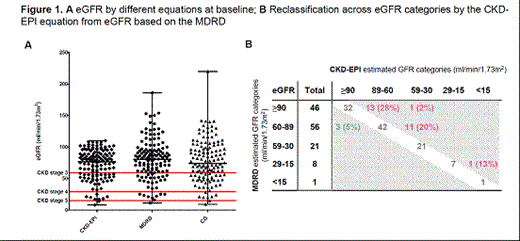Abstract
Renal impairment (RI) in patients with MM is detrimental organ damage. The estimation of glomerular filtration (eGFR) rates is based on using different equations such as CKD-EPI, MDRD or Cockcroft-Gault (CG). Methods: We enrolled 132 consecutive MM patients treated with lenalidomide for the approved indication in our department between 2006 and 2012. The GFR for quantifying RI was estimated by the CKD-EPI, MDRD- and CG-equations at baseline and after 3 months under lenalidomide therapy. We assessed hematological response by the EBMT criteria, and renal response according to recently proposed criteria (Dimopolous et al. Leukemia 2013) and by comparing the CKD-EPI, MDRD- and CG equations.
Median patient age was 64 years (range 41-90; males 62%) with predominantly advanced stage II/III Durie & Salmon and International Staging System disease (96% vs. 65%, respectively). Fifty-four MM patients had received ≥2 therapy lines and 50% prior stem cell transplantation. The median lenalidomide dose was 25mg (D1-21/28 day cycle) given with dexamethasone (Rd) as published. The median serum creatinine was normal at 1.0mg/dl, whereas the median eGFR showed CKD stage 2, with substantially different median CKD-EPI, MDRD and CG equations of 77, 81 and 74ml/min/1.73m2, respectively (Figure 1A). For each equation, the number of patients with CKD stage 3–5 via CKD-EPI, MDRD and CG equation was 32%, 23% and 30%, respectively (Table 1). In total, 26 (20%) MM patients with eGFR values by the MDRD equation were reclassified to higher CKD-stages according to CKD-EPI equation and 3 (2%) to lower CKD stages (Figure 1B). This demonstrates that the MDRD may substantially overestimate the GFR, especially in elderly patients with normal or less impaired renal function (GFR >60ml/min/1.73m2). Best overall response (ORR=CR+PR) and clinical benefit rate (CR, PR, SD) in this advanced, substantially pretreated cohort was 48% and 93%, respectively. After 3 months, renal response (CR, PR, MR) according to CKD-EPI, MDRD and CG were 17%, 11% and 15%, respectively, and renal response defined as any eGFR improvement was 52%, 51% and 51%, respectively. For each eGFR equation, the number of patients with renal improvement according to CKD stage 1-2 was more pronounced with the CKD-EPI (68% → 76%), less with the MDRD (77% → 83%) and least with the CG equation (70% → 75%; Table 1).
Estimated CKD stages and prevalence of CKD stages 3-5 by different eGFR equations at baseline and after 3 months lenalidomide therapy
| . | Baseline . | After 3 months . | Baseline . | After 3 months . | Baseline . | After 3 months . | ||||||
|---|---|---|---|---|---|---|---|---|---|---|---|---|
| Variables . | CKD-EPI . | MDRD . | Cockcroft-Gault . | |||||||||
| . | n (%) . | . | n (%) . | . | n (%) . | . | n (%) . | . | n (%) . | . | n (%) . | . |
| CKD stage (ml/min/1.73m²) | ||||||||||||
| 1: eGFR ≥90 | 35 (26) | 68% | 40 (33) | 76% | 46 (35) | 77% | 49 (41) | 83% | 49 (37) | 70% | 47 (39) | 75% |
| 2: eGFR 89-60 | 55 (42) | 51 (43) | 56 (42) | 50 (42) | 43 (33) | 43 (36) | ||||||
| 3: eGFR 59-30 | 33 (25) | 32% | 22 (18) | 24% | 21 (16) | 23% | 14 (12) | 17% | 32 (24) | 30% | 23 (19) | 25% |
| 4: eGFR 29-15 | 7 (5) | 6 (5) | 8 (6) | 7 (5) | 7 (5) | 5 (5) | ||||||
| 5: eGFR <15 | 2 (2) | 1 (1) | 1 (1) | 0 (0) | 1 (1) | 1 (1) | ||||||
| . | Baseline . | After 3 months . | Baseline . | After 3 months . | Baseline . | After 3 months . | ||||||
|---|---|---|---|---|---|---|---|---|---|---|---|---|
| Variables . | CKD-EPI . | MDRD . | Cockcroft-Gault . | |||||||||
| . | n (%) . | . | n (%) . | . | n (%) . | . | n (%) . | . | n (%) . | . | n (%) . | . |
| CKD stage (ml/min/1.73m²) | ||||||||||||
| 1: eGFR ≥90 | 35 (26) | 68% | 40 (33) | 76% | 46 (35) | 77% | 49 (41) | 83% | 49 (37) | 70% | 47 (39) | 75% |
| 2: eGFR 89-60 | 55 (42) | 51 (43) | 56 (42) | 50 (42) | 43 (33) | 43 (36) | ||||||
| 3: eGFR 59-30 | 33 (25) | 32% | 22 (18) | 24% | 21 (16) | 23% | 14 (12) | 17% | 32 (24) | 30% | 23 (19) | 25% |
| 4: eGFR 29-15 | 7 (5) | 6 (5) | 8 (6) | 7 (5) | 7 (5) | 5 (5) | ||||||
| 5: eGFR <15 | 2 (2) | 1 (1) | 1 (1) | 0 (0) | 1 (1) | 1 (1) | ||||||
To the best of our knowledge, we are the first to demonstrate that measuring renal function by the CKD-EPI equation in Rd-treated MM patients is highly valuable. In these substantially pretreated MM patients, renal response under lenalidomide was seen via CKD-EPI in 17% and any eGFR improvements in 52%, indicating that Rd in these patients is effective and RI best defined via CKD-EPI. Our results enlarge the arsenal of available eGFR equations by the CKD-EPI formula.
Kleber:Celgene: Educational grant Other. Engelhardt:Celgene: Educational grant Other.
Author notes
Asterisk with author names denotes non-ASH members.


This feature is available to Subscribers Only
Sign In or Create an Account Close Modal